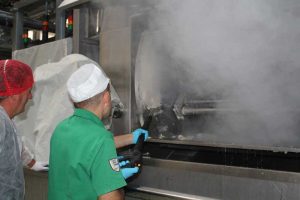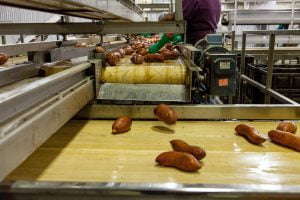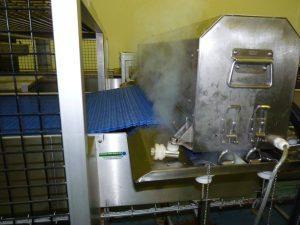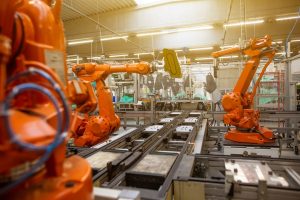Maintaining clean conveyor belts is of utmost importance in food manufacturing plants. These belts are responsible for transporting food products from one area to another, and any contamination on the belts can lead to serious health risks. Dirty conveyor belts can harbor bacteria, allergens, and other contaminants that can contaminate the food being processed. This can result in foodborne illnesses and product recalls, which can have severe consequences for both consumers and manufacturers.
In addition to food safety concerns, dirty conveyor belts can also lead to operational issues. Debris and contaminants on the belts can cause blockages or jams, resulting in production delays and increased downtime. This can have a negative impact on productivity and profitability for food manufacturing plants.
Factors Affecting the Need for Conveyor Belt Cleaners
The need for conveyor belt cleaners can be influenced by various factors. One such factor is the type of food being processed. Different types of foods have different levels of contamination risk, and therefore may require different levels of cleaning. For example, raw meats and poultry pose a higher risk of contamination compared to packaged snacks or beverages.
Another factor that can affect the need for conveyor belt cleaners is the environment in which the food is processed. Food manufacturing plants can vary in terms of temperature, humidity, and other environmental conditions. These conditions can impact the growth and survival of bacteria and other contaminants, and therefore may require more frequent or intensive cleaning of conveyor belts.
Types of Conveyor Belt Cleaners
There are several types of conveyor belt cleaners available for use in food manufacturing plants. These include mechanical cleaners, chemical cleaners, and steam vapour cleaners.
Mechanical cleaners are designed to physically remove debris and contaminants from the surface of the conveyor belts. They typically consist of brushes or scrapers that are mounted on the belt to scrape off any residue. Mechanical cleaners are effective at removing larger particles, but may not be as effective at removing smaller particles or sanitizing the belts.
Chemical cleaners, on the other hand, use cleaning agents or disinfectants to remove contaminants from the conveyor belts. These cleaners are often used in conjunction with mechanical cleaners to provide a more thorough cleaning. Chemical cleaners can be effective at removing a wide range of contaminants, but care must be taken to ensure that the cleaning agents used are safe for food contact surfaces.
Steam vapour cleaners are a relatively new technology that uses high-pressure steam to clean and sanitize conveyor belts. These cleaners are highly effective at removing both visible and invisible contaminants, and can also kill bacteria and other pathogens. Steam vapour cleaners are often preferred in food manufacturing plants due to their ability to provide a deep clean without the use of chemicals.
Advantages and Disadvantages of Steam Vapour Cleaning Machines
| Type of Conveyor Belt Cleaner | Description | Advantages | Disadvantages |
|---|---|---|---|
| Primary Cleaners | Installed on the head pulley and remove the bulk of carryback material. | Effective at removing large amounts of material, reducing maintenance costs and increasing productivity. | May require frequent adjustment and can cause belt wear if not properly maintained. |
| Secondary Cleaners | Installed after the primary cleaner and remove any remaining carryback material. | Improve cleaning efficiency and reduce the risk of belt damage. | May require more frequent maintenance and can be more expensive than primary cleaners. |
| Tertiary Cleaners | Installed at the end of the conveyor and remove any remaining carryback material. | Ensure maximum cleaning efficiency and reduce the risk of material build-up in the tail pulley area. | May require more frequent maintenance and can be the most expensive type of cleaner. |
Steam vapour cleaning machines offer several advantages over other types of conveyor belt cleaners. One major advantage is their ability to sanitize and disinfect the belts. The high-pressure steam can kill bacteria, viruses, and other pathogens, ensuring that the belts are free from any harmful microorganisms.
Another advantage of steam vapour cleaning machines is their versatility. These machines can be used on a wide range of conveyor belt materials, including rubber, plastic, and metal. They can also be used to clean other equipment and surfaces in the food manufacturing plant, making them a versatile cleaning solution.
However, there are also some disadvantages to using steam vapour cleaning machines. One disadvantage is the cost. Steam vapour cleaning machines can be more expensive than other types of cleaners, and may require additional equipment or accessories for optimal performance.
Another disadvantage is the potential for moisture damage. The high-pressure steam used in these machines can cause moisture to penetrate into the conveyor belts, which can lead to damage or degradation over time. This can result in increased maintenance and replacement costs for the belts.
How Steam Vapour Cleaning Machines Work
Steam vapour cleaning machines work by heating water to a high temperature and then converting it into steam. The steam is then released through a nozzle at high pressure, which can effectively remove dirt, debris, and contaminants from the surface of the conveyor belts.
The high temperature of the steam helps to break down and dissolve grease, oils, and other stubborn residues that may be present on the belts. The high pressure of the steam helps to dislodge these residues from the surface of the belts, allowing them to be easily wiped away.
In addition to cleaning, steam vapour cleaning machines also have the ability to sanitize and disinfect the conveyor belts. The high temperature of the steam can kill bacteria, viruses, and other pathogens, ensuring that the belts are free from any harmful microorganisms.
Benefits of Using Automatic Conveyor Belt Steam Vacuum Cleaners

Automatic conveyor belt steam vacuum cleaners offer several benefits over manual cleaning methods. One major benefit is increased efficiency. These machines are designed to clean large areas quickly and effectively, reducing the amount of time and labor required for cleaning.
Another benefit is reduced labor costs. Manual cleaning methods often require multiple workers to clean the conveyor belts, which can be time-consuming and costly. Automatic steam vacuum cleaners can be operated by a single worker, reducing the need for additional labor.
Additionally, automatic conveyor belt steam vacuum cleaners provide a more thorough and consistent clean compared to manual methods. These machines are designed to remove both visible and invisible contaminants from the belts, ensuring that they are free from any debris or microorganisms.
Factors to Consider When Choosing Conveyor Belt Cleaners
When choosing conveyor belt cleaners for food manufacturing plants, there are several factors that should be considered. One factor is the type of food being processed. Different types of foods have different levels of contamination risk, and therefore may require different levels of cleaning. For example, raw meats and poultry pose a higher risk of contamination compared to packaged snacks or beverages.
Another factor to consider is the cleaning requirements. Some food manufacturing plants may have specific cleaning requirements or regulations that must be followed. It is important to choose conveyor belt cleaners that meet these requirements and ensure compliance with food safety standards.
The environment in which the food is processed is also an important factor to consider. Food manufacturing plants can vary in terms of temperature, humidity, and other environmental conditions. These conditions can impact the growth and survival of bacteria and other contaminants, and therefore may require more frequent or intensive cleaning of conveyor belts.
Maintenance and Cleaning of Conveyor Belt Cleaners
Proper maintenance and cleaning of conveyor belt cleaners is essential to ensure their effectiveness. Regular maintenance can help to prevent issues such as blockages or malfunctions, which can impact the performance of the cleaners.
One important aspect of maintenance is regular inspection of the cleaners. This involves checking for any signs of wear or damage, such as worn brushes or broken scrapers. Any worn or damaged parts should be replaced promptly to ensure optimal performance.
Cleaning the conveyor belt cleaners themselves is also important. This involves removing any debris or contaminants that may have accumulated on the cleaners. This can be done using a brush or scraper, or by using a vacuum cleaner to remove any loose particles.
The Future of Conveyor Belt Cleaning in Food Manufacturing Plants
In conclusion, maintaining clean conveyor belts is crucial in food manufacturing plants to ensure food safety and prevent contamination. Dirty conveyor belts can lead to serious health risks and operational issues. Factors such as the type of food being processed and the environment in which it is processed can affect the need for conveyor belt cleaners.
There are several types of conveyor belt cleaners available, including mechanical, chemical, and steam vapour cleaners. Steam vapour cleaning machines offer several advantages, such as their ability to sanitize and disinfect the belts. However, there are also some disadvantages to using these machines, such as the potential for moisture damage.
Automatic conveyor belt steam vacuum cleaners offer increased efficiency and reduced labor costs compared to manual cleaning methods. When choosing conveyor belt cleaners, factors such as the type of food being processed and the cleaning requirements should be considered. Proper maintenance and cleaning of conveyor belt cleaners is essential to ensure their effectiveness.
In the future, we can expect to see new technologies and innovations in conveyor belt cleaning in food manufacturing plants. These may include advancements in steam vapour cleaning machines, such as improved efficiency and reduced moisture damage. Overall, the future of conveyor belt cleaning looks promising, with a focus on improving food safety and operational efficiency in food manufacturing plants.
FAQs
What is a conveyor belt cleaning system?
A conveyor belt cleaning system is a set of equipment and procedures used to remove debris, dirt, and other contaminants from conveyor belts in a food manufacturing plant.
Why is it important to assess the needs for a conveyor belt cleaning system?
Assessing the needs for a conveyor belt cleaning system is important to ensure that the system is effective in removing contaminants from the conveyor belts, preventing contamination of food products, and complying with food safety regulations.
What factors should be considered when assessing the needs for a conveyor belt cleaning system?
Factors that should be considered when assessing the needs for a conveyor belt cleaning system include the type of food products being manufactured, the level of contamination risk, the size and layout of the plant, the frequency of cleaning required, and the available budget.
What are the different types of conveyor belt cleaning systems?
The different types of conveyor belt cleaning systems include mechanical belt scrapers, belt brushes, air knives, and water-based cleaning systems.
What are the advantages of using a mechanical belt scraper?
The advantages of using a mechanical belt scraper include its effectiveness in removing debris and contaminants from the conveyor belt, its low cost, and its ease of maintenance.
What are the disadvantages of using a water-based cleaning system?
The disadvantages of using a water-based cleaning system include the high cost of installation and maintenance, the potential for water to damage electrical equipment, and the need for proper wastewater treatment to comply with environmental regulations.
What are the benefits of outsourcing conveyor belt cleaning?
The benefits of outsourcing conveyor belt cleaning include reduced costs, increased efficiency, improved food safety, and access to specialized equipment and expertise.










